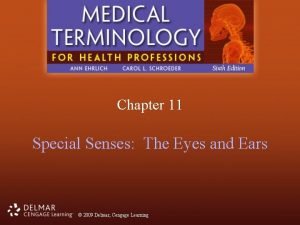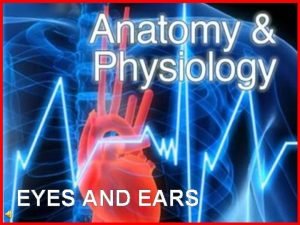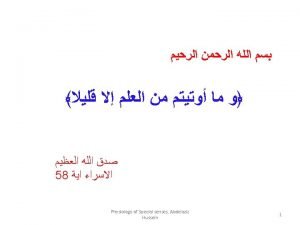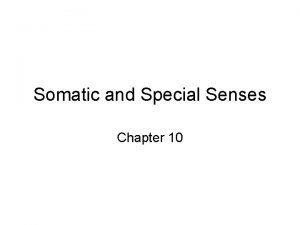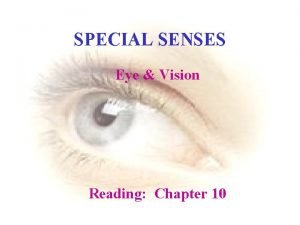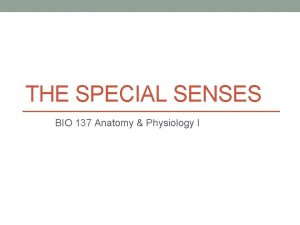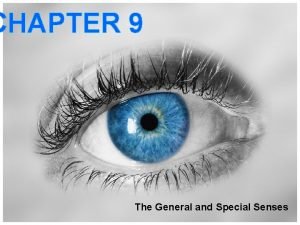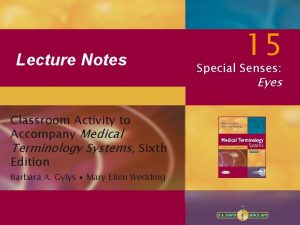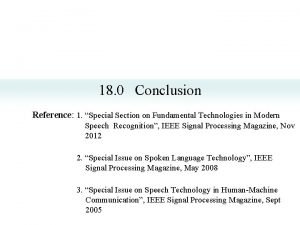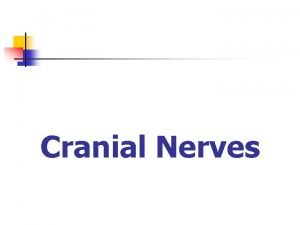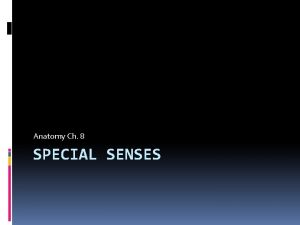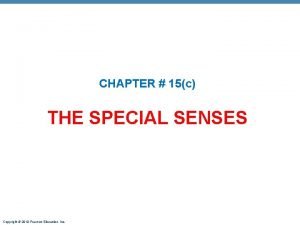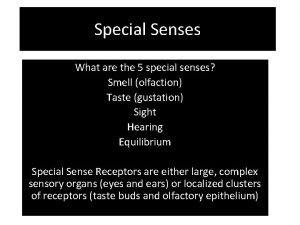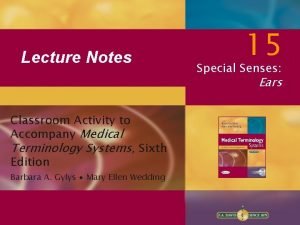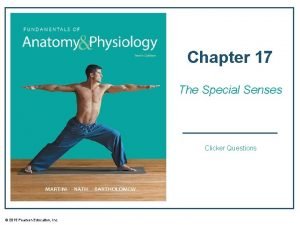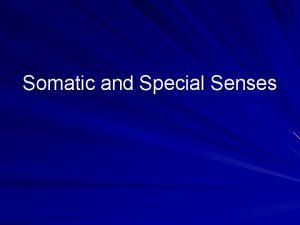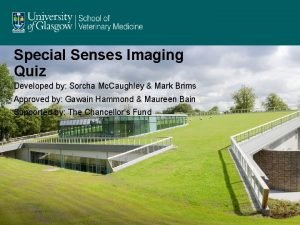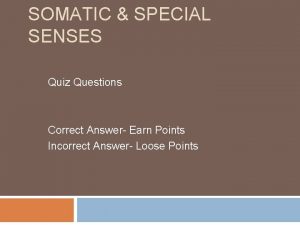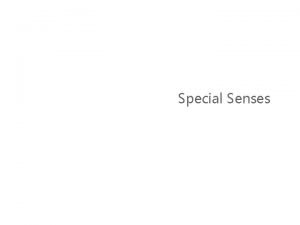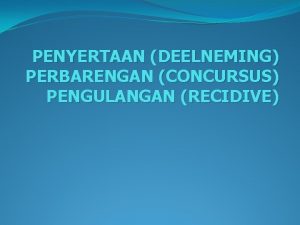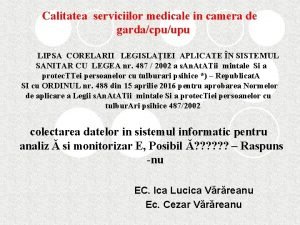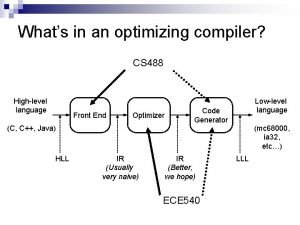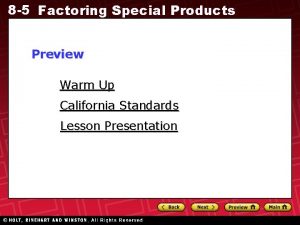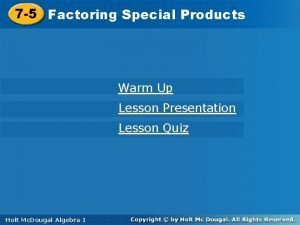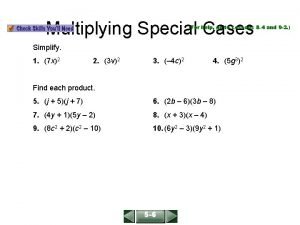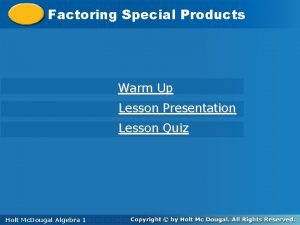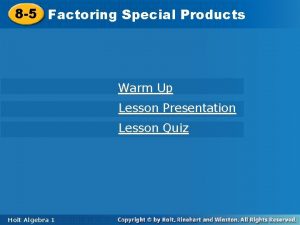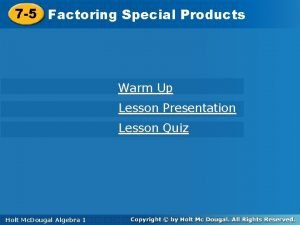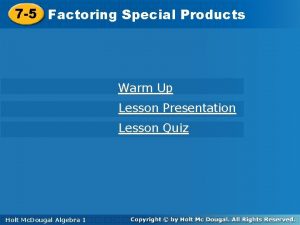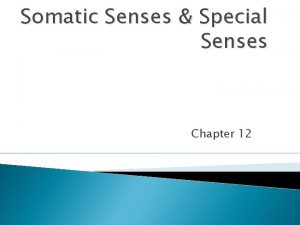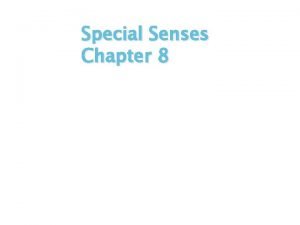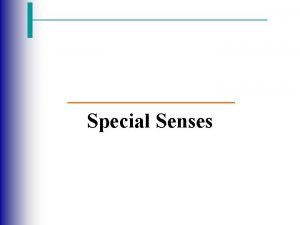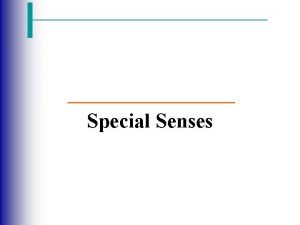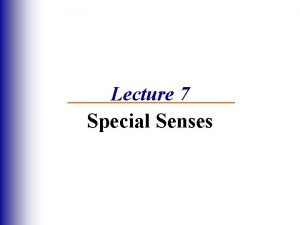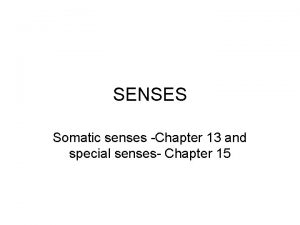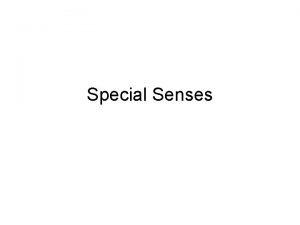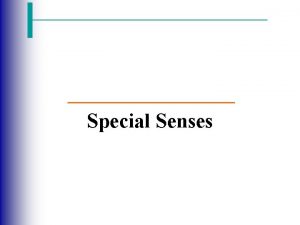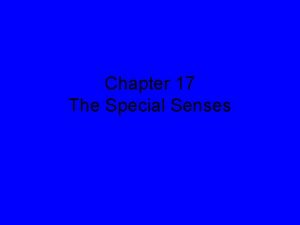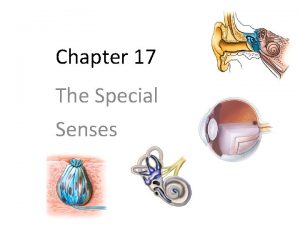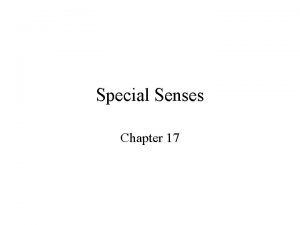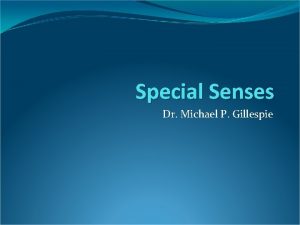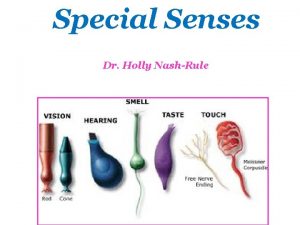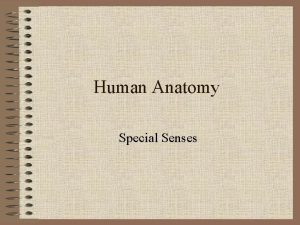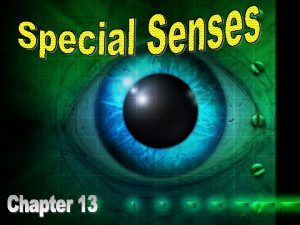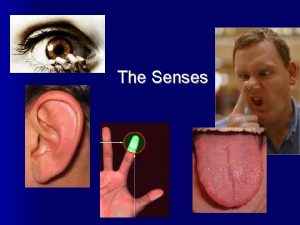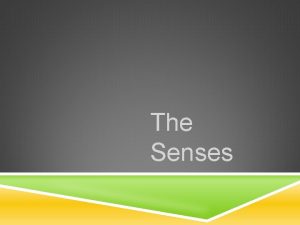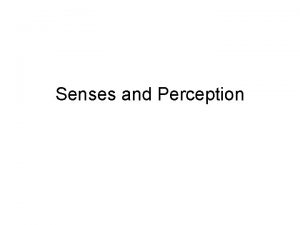16 PART 1 The Special Senses Pages 488






































































- Slides: 70

16 PART 1 The Special Senses Pages 488 -502, 506514 Power. Point® Lecture Presentations prepared by Leslie Hendon University of Alabama, Birmingham © 2014 Pearson Education, Inc.

The Special Senses • Taste, smell, sight, hearing, and balance • Touch—a large group of general senses • Special sensory receptors • Localized—confined to the head region • Receptors are not free endings of sensory neurons • Special receptor cells • Are neuronlike epithelial cells or small peripheral neurons • Transfer sensory information to other neurons © 2014 Pearson Education, Inc.

The Chemical Senses: Taste and Smell • Taste—gustation • Smell—olfaction • Receptors—classified as chemoreceptors • Respond to chemicals • Food dissolved in saliva • Airborne chemicals that dissolve in fluids of the nasal mucosa © 2014 Pearson Education, Inc.

Taste—Gustation • Taste receptors • Occur in taste buds • Most are found on the surface of the tongue • Located within tongue papillae • Two types of papillae (with taste buds) • Fungiform papillae • Vallate papillae © 2014 Pearson Education, Inc.

Taste Buds • Collection of 50– 100 epithelial cells • Contain two major cell types • Gustatory epithelial cells supporting cells • Basal epithelial cells gustatory cells • Contain long microvilli—extend through a taste pore to the surface of the epithelium • Cells in tastebuds replaced every 7– 10 days © 2014 Pearson Education, Inc.

Taste Buds Epiglottis Connective tissue Palatine tonsil Taste fibers of cranial nerve Gustatory hair Lingual tonsil Vallate papilla Basal Gustatory epithelial cells Fungiform papillae (a) Taste buds associated with fungiform and vallate papillae © 2014 Pearson Education, Inc. Taste pore Stratified squamous epithelium of tongue Taste bud (b) Enlarged section of a vallate papilla (c) Enlarged view of a taste bud (micrograph, 160 X) Figure 16. 1

Smell (Olfaction) • Olfactory receptors are part of the olfactory epithelium • Olfactory epithelium is pseudostratified columnar and contains three main cell types • Olfactory sensory neurons • Supporting epithelial cells • Basal epithelial cells © 2014 Pearson Education, Inc.

Smell (Olfaction) • Cell bodies of olfactory sensory neurons • Located in olfactory epithelium • Have an apical dendrite that projects to the epithelial surface • Ends in a knob from which olfactory cilia radiate • Olfactory cilia act as receptive structures for smell • Mucus captures and dissolves odor molecules © 2014 Pearson Education, Inc.

Smell (Olfaction) • Axons of olfactory epithelium • Gather into bundles—filaments of the olfactory nerve • Pass through the cribriform plate of the ethmoid bone • Attach to the olfactory bulbs and synapse with mitral cells • Mitral cells transmit impulses along the olfactory tract to 1. Limbic system 2. Piriform lobe of the cerebral cortex © 2014 Pearson Education, Inc.

Olfactory Receptors Olfactory epithelium Olfactory tract Mitral cell (output cell) Glomeruli Olfactory bulb Olfactory tract Olfactory bulb Nasal conchae (a) Route of inhaled air Cribriform plate of ethmoid bone Olfactory gland Olfactory epithelium Filaments of olfactory nerve Lamina propria connective tissue Axon Basal cell Olfactory sensory neuron Supporting cell Dendrite Olfactory cilia Mucus (b) © 2014 Pearson Education, Inc. Route of inhaled air containing odor molecules Figure 16. 3

The Eye and Vision • Visual organ—the eye • 70% of all sensory receptors are in the eyes • 40% of the cerebral cortex is involved in processing visual information • Anterior one-sixth of the eye’s surface is visible © 2014 Pearson Education, Inc.

Accessory Structures of the Eye • Eyebrows—coarse hairs on the superciliary arches • Eyelids (palpebrae)—separated by the palpebral fissure • Meet at the medial and lateral angles (canthi) • Lacrimal caruncle—reddish elevation at the medial canthus • Tarsal plates—connective tissue within the eyelids • Tarsal glands—modified sebaceous glands © 2014 Pearson Education, Inc.

© 2014 Pearson Education, Inc.

Accessory Structures of the Eye • Conjunctiva— transparent mucous membrane • Palpebral conjunctiva Levator palpebrae superioris muscle Orbicularis oculi muscle Eyebrow Tarsal plate Palpebral conjunctiva Tarsal glands Cornea Palpebral fissure • Bulbar conjunctiva • Conjunctival sac (b) Lateral view; some structures shown in sagittal section © 2014 Pearson Education, Inc. Eyelashes Bulbar conjunctiva Conjunctival sac Orbicularis oculi muscle Figure 16. 4 b

Accessory Structures of the Eye • Lacrimal apparatus Lacrimal sac gland —keeps the surface Lacrimal Excretory ducts of lacrimal glands of the eye moist • Lacrimal gland— produces lacrimal fluid • Lacrimal sac— fluid empties into nasal cavity © 2014 Pearson Education, Inc. Lacrimal punctum Lacrimal canaliculus Nasolacrimal duct Inferior meatus of nasal cavity Nostril Figure 16. 5

Extrinsic Eye Muscles • Six muscles that control movement of the eye • Originate in the walls of the orbit • Insert on outer surface of the eyeball • Annular ring—origin of the four rectus muscles • The six extrinsic eye muscles are • Lateral rectus and medial rectus • Superior rectus and inferior rectus • Superior oblique and inferior oblique © 2014 Pearson Education, Inc.

Extrinsic Eye Muscles Superior oblique muscle Trochlea Superior oblique tendon Superior rectus muscle Superior oblique Superior rectus Medial rectus Lateral rectus muscle Inferior oblique Common tendinous ring Inferior rectus muscle Inferior oblique muscle (a) Lateral view of the right eye © 2014 Pearson Education, Inc. Inferior rectus (b) Anterior view of the right eye Figure 16. 6 a, b

Summary of Muscle Actions Muscle Lateral rectus Medial rectus Superior rectus Inferior oblique Superior oblique Action Controlling cranial nerve Moves eye laterally Moves eye medially Elevates eye and turns it medially Depresses eye and turns it medially Elevates eye and turns it laterally Depresses eye and turns it laterally VI (abducens) III (oculomotor) IV (trochlear) (c) Summary of muscle actions and innervating cranial nerves © 2014 Pearson Education, Inc. Figure 16. 6 c

Anatomy of the Eyeball • Components of the eye • Protect and support the photoreceptors • Gather, focus, and process light into precise images • Anterior pole—most anterior part of the eye • Posterior pole—most posterior part of the eye • External walls—composed of three tunics • Internal cavity—contains fluids (humors) © 2014 Pearson Education, Inc.

The Fibrous Layer • Most external layer of the eyeball • Composed of two regions of connective tissue • Sclera—posterior five-sixths of the tunic • White, opaque region • Provides shape and an anchor for eye muscles • Cornea—anterior one-sixth of the fibrous tunic • Epithelial stem cells • Transparent • Avascular but rich with nerve endings © 2014 Pearson Education, Inc.

Medial View of the Eye Ora serrata Ciliary body Ciliary zonule (suspensory ligament) Cornea Iris Pupil Anterior pole Sclera Choroid Retina Macula lutea Fovea centralis Posterior pole Optic nerve Anterior segment (contains aqueous humor) Lens Central artery Scleral venous and vein of sinus the retina Posterior segment Optic disc (contains vitreous humor) (blind spot) (a) Diagrammatic view. The vitreous humor is illustrated only in the bottom part of the eyeball. © 2014 Pearson Education, Inc. Figure 16. 7 a

Figure 16. 7 b Internal structure of the eye ( sagittal section). Ciliary body Vitreous humor in posterior segment Ciliary processes Retina Iris Choroid Margin of pupil Sclera Anterior segment Fovea centralis Lens Optic nerve Optic disc Cornea Ciliary zonule (suspensory ligament) Photograph of the human eye © 2014 Pearson Education, Inc.

© 2014 Pearson Education, Inc.

The Vascular Layer • The middle coat of the eyeball • Composed of choroid, ciliary body, and iris • Choroid—vascular, darkly pigmented membrane • Forms posterior five-sixths of the vascular tunic • Brown color—from melanocytes • Prevents scattering of light rays within the eye • Choroid corresponds to the arachnoid and pia maters © 2014 Pearson Education, Inc.

The Vascular Layer • Ciliary body—thickened ring of tissue, which encircles the lens • Composed of ciliary muscle & ciliary processes • Ciliary processes—posterior surface of the ciliary body • Ciliary zonule (suspensory ligament) • Attached around entire circumference of the lens © 2014 Pearson Education, Inc.

The Vascular Layer Ora serrata Ciliary body Ciliary zonule (suspensory ligament) Cornea Iris Pupil Anterior pole Sclera Choroid Retina Macula lutea Fovea centralis Posterior pole Optic nerve Anterior segment (contains aqueous humor) Lens Central artery Scleral venous and vein of sinus the retina Posterior segment Optic disc (contains vitreous humor) (blind spot) (a) Diagrammatic view. The vitreous humor is illustrated only in the bottom part of the eyeball. © 2014 Pearson Education, Inc. Figure 16. 7 a

The Iris • Visible colored part of the eye • Attached to the ciliary body • Composed of smooth muscle • Pupil—the round, central opening • Sphincter pupillae muscle • Dilator pupillae muscle • Act to vary the size of the pupil • Pupillary light reflex • Protective response of pupil constriction when a bright light is flashed in the eye © 2014 Pearson Education, Inc.

Figure 16. 8 Pupil dilation and constriction, anterior view. Sympathetic Parasympathetic Sphincter pupillae muscle contracts: Pupil size decreases. © 2014 Pearson Education, Inc. Iris (two muscles) • Sphincter pupillae • Dilator pupillae muscle contracts: Pupil size increases.

The Inner Layer (Retina) • Retina—the deepest tunic • Composed of two layers • Pigmented layer—single layer of melanocytes • Neural layer—sheet of nervous tissue • Contains three main types of neurons • Photoreceptor cells • Bipolar cells • Ganglion cells © 2014 Pearson Education, Inc.

Posterior Aspect of the Eyeball Neural layer of retina Pigmented layer of retina Choroid Sclera Pathway of light Optic disc Central artery and vein of retina Optic nerve (a) Posterior aspect of the eyeball © 2014 Pearson Education, Inc. Figure 16. 9 a

Microscopic Anatomy of the Retina Ganglion cells Bipolar cells Photoreceptors Rod Cone Nuclei of ganglion cells Outer segments of rods and cones Choroid Amacrine cell Horizontal cell Pathway of signal output Pathway of light Pigmented layer of retina (b) Cells of the neural layer of the retina © 2014 Pearson Education, Inc. Axons of ganglion cells Nuclei of of bipolar rods and cells cones Pigmented layer of retina (c) Photomicrograph of retina Figure 16. 9 b, c

The Inner Layer • Photoreceptor cells signal bipolar cells • Bipolar cells signal ganglion cells to generate nerve impulses • Axons from ganglion cells run along internal surface of the retina • Converge posteriorly to form the optic nerve © 2014 Pearson Education, Inc.

Light t Ligh Lig ht Photoreceptors Process of bipolar cell Synaptic terminals Inner fibers • Two main types Rod cell body Nuclei • Rod cells—more sensitive to light • Enable high-acuity, color vision • Considered neurons Pigmented layer light Outer segment • Cone cells—operate best in bright Mitochondria Outer fiber Connecting cilia Inner segment • Allow vision in dim light Cone cell body Apical microvillus Discs containing visual pigments Discs being phagocytized Melanin granules Pigment cell nucleus Basal lamina (border with choroid) © 2014 Pearson Education, Inc. Figure 16. 10

Photoreceptors • Rods and cones have an inner and outer segment • Outer segments are receptor regions • Light absorbing pigments are present • Light particles modify the visual pigment and generate a nerve impulse • Vulnerable to damage by light or heat • Cannot regenerate if destroyed • Continuously renew and replace their outer segments © 2014 Pearson Education, Inc.

Regional Specializations of the Retina • Ora serrata retinae • Neural layer ends at the posterior margin of the ciliary body • Pigmented layer covers ciliary body and posterior surface of the iris • Macula lutea—contains mostly cones • Fovea centralis—contains only cones • Region of highest visual acuity • Optic disc—blind spot © 2014 Pearson Education, Inc.

Medial View of the Eye Ora serrata Ciliary body Ciliary zonule (suspensory ligament) Cornea Iris Pupil Anterior pole Sclera Choroid Retina Macula lutea Fovea centralis Posterior pole Optic nerve Anterior segment (contains aqueous humor) Lens Central artery Scleral venous and vein of sinus the retina Posterior segment Optic disc (contains vitreous humor) (blind spot) (a) Diagrammatic view. The vitreous humor is illustrated only in the bottom part of the eyeball. © 2014 Pearson Education, Inc. Figure 16. 7 a

Blood Supply of the Retina • Retina receives blood from two sources • Outer third of the retina—supplied by capillaries in the choroid Central artery and vein emerging from the optic disc Macula lutea Optic disc Retina • Inner two-thirds of the retina— supplied by central artery and vein of the retina © 2014 Pearson Education, Inc. Figure 16. 11

Internal Chambers and Fluids • The lens and ciliary zonules divide the eye • Posterior segment (cavity) • Filled with vitreous humor • Clear, jelly-like substance • Transmits light • Supports the posterior surface of the lens • Helps maintain intraocular pressure © 2014 Pearson Education, Inc.

Internal Chambers and Fluids • Anterior segment • Divided into anterior and posterior chambers • Anterior chamber—between the cornea and iris • Posterior chamber—between the iris and lens • Filled with aqueous humor • Renewed continuously • Formed as a blood filtrate • Supplies nutrients to the lens and cornea © 2014 Pearson Education, Inc.

Internal Chambers and Fluids Cornea Lens Posterior segment (contains vitreous humor) Iris Lens epithelium Lens Cornea 2 Corneal epithelium Corneal endothelium Aqueous humor 1 Aqueous humor is formed by filtration from the capillaries in the ciliary processes. 2 Aqueous humor flows from the posterior chamber through the pupil into the anterior chamber. Some also flows through the vitreous humor (not shown). 3 Aqueous humor is reabsorbed into the venous blood by the scleral venous sinus. © 2014 Pearson Education, Inc. Anterior segment (contains aqueous humor) Anterior chamber Ciliary zonule (suspensory ligament) Posterior chamber 3 Scleral venous sinus Corneoscleral junction 1 Ciliary processes Ciliary muscle Ciliary body Bulbar conjunctiva Sclera Figure 16. 12

The Lens • A thick, transparent, biconvex disc • Held in place by its ciliary zonule • Lens epithelium—covers anterior surface of the lens • Lens fibers form the bulk of the lens • New lens fibers are continuously added • Lens enlarges throughout life PLAY Vision © 2014 Pearson Education, Inc.

The Eye as an Optical Device • Structures in the eye bend light rays • Light rays converge on the retina at a single focal point • Light bending structures (refractory media) are • The lens, cornea, and humors • Accommodation—curvature of the lens is adjustable • Allows for focusing on nearby objects © 2014 Pearson Education, Inc.

The Eye as an Optical Device Sympathetic activation Nearly parallel rays from distant object Lens Ciliary zonule Ciliary muscle Inverted image (a) Lens is flattened for distant vision. Sympathetic input relaxes the ciliary muscle, tightening the ciliary zonule, and flattening the lens. Parasympathetic activation Divergent rays from close object © 2014 Pearson Education, Inc. Inverted image (b) Lens bulges for close vision. Parasympathetic input contracts the ciliary muscle, loosening the ciliary zonule, allowing the lens to bulge. Figure 16. 13

The Ear: Hearing and Equilibrium • The ear—receptor organ for hearing and equilibrium • Composed of three main regions • Outer ear—functions in hearing • Middle ear—functions in hearing • Internal ear—functions in both hearing and equilibrium © 2014 Pearson Education, Inc.

The Outer (External) Ear • Composed of • The auricle (pinna) • Helps direct sounds • External acoustic meatus • Lined with skin • Contains hairs, sebaceous glands, and ceruminous glands • Tympanic membrane • Forms the boundary between the external and middle ear © 2014 Pearson Education, Inc.

Structure of the Ear External ear Middle ear Internal ear (labyrinth) Auricle (pinna) Helix Lobule External acoustic meatus (a) The three regions of the ear © 2014 Pearson Education, Inc. Tympanic membrane Pharyngotympanic (auditory) tube Figure 16. 16 a

The Middle Ear • Composed of • The tympanic cavity • A small, air-filled space • Located within the petrous portion of the temporal bone • Medial wall is penetrated by • Oval window • Round window • Pharyngotympanic tube (auditory or eustachian tube) • Links the middle ear and pharynx © 2014 Pearson Education, Inc.

Structures of the Middle Ear Oval window (deep to stapes) Entrance to mastoid antrum in the epitympanic recess Auditory ossicles Malleus (hammer) Incus (anvil) Stapes (stirrup) Tympanic membrane Round window Semicircular canals Vestibule Vestibular nerve Cochlea Pharyngotympanic (auditory) tube (b) Middle and internal ear © 2014 Pearson Education, Inc. Figure 16. 16 b

The Middle Ear • Ear ossicles— smallest bones in the body • Malleus—attaches to the eardrum • Incus—between the malleus and stapes View Malleus Incus Epitympanic recess Superior Lateral Anterior • Stapes—vibrates against the oval window • Tensor tympani and stapedius • Two tiny skeletal muscles in the © 2014 Pearson Education, ear Inc. cavity middle Pharyngotympanic tube Tensor Tympanic Stapes Stapedius tympani membrane muscle (medial view) Figure 16. 17

The Internal Ear • Internal ear—also called the labyrinth • Lies within the petrous portion of the temporal bone • Bony labyrinth—a cavity consisting of three parts • Semicircular canals • Vestibule • Cochlea © 2014 Pearson Education, Inc.

The Internal Ear Oval window (deep to stapes) Entrance to mastoid antrum in the epitympanic recess Auditory ossicles Malleus (hammer) Incus (anvil) Stapes (stirrup) Tympanic membrane Round window Semicircular canals Vestibule Vestibular nerve Cochlea Pharyngotympanic (auditory) tube (b) Middle and internal ear © 2014 Pearson Education, Inc. Figure 16. 16 b

The Internal Ear • Membranous labyrinth • Series of membrane-walled sacs and ducts • Fit within the bony labyrinth • Consists of three main parts • Semicircular ducts • Utricle and saccule • Cochlear duct © 2014 Pearson Education, Inc.

The Internal Ear • Membranous labyrinth (continued) • Filled with a clear fluid—endolymph • Confined to the membranous labyrinth • Bony labyrinth is filled with perilymph • Continuous with cerebrospinal fluid © 2014 Pearson Education, Inc.

The Internal Ear Temporal bone Semicircular ducts in semicircular canals Anterior Posterior Lateral Cristae ampullares in the membranous ampullae Utricle in vestibule Saccule in vestibule © 2014 Pearson Education, Inc. Facial nerve Vestibular nerve Superior vestibular ganglion Inferior vestibular ganglion Cochlear nerve Maculae Spiral organ (of Corti) Cochlear duct in cochlea Stapes in oval window Round window Figure 16. 18

The Cochlea • A spiraling chamber in the bony labyrinth • Coils around a pillar of bone—the modiolus • Spiral lamina—a spiral of bone in the modiolus • The cochlear nerve runs through the core of the modiolus © 2014 Pearson Education, Inc.

Figure 16. 19 Anatomy of the cochlea. Helicotrema at apex Modiolus Cochlear nerve, division of the vestibulocochlear nerve (VIII) Spiral ganglion Osseous spiral lamina Vestibular membrane Cochlear duct (scala media) Vestibular membrane Tectorial membrane Cochlear duct (scala media; contains endolymph) Osseous spiral lamina Scala vestibuli (contains perilymph) Basilar membrane Inner hair cell Hairs (stereocilia) Afferent nerve fibers Outer hair cells Supporting cells Stria vascularis Spiral organ Spiral ganglion Tectorial membrane Fibers of cochlear nerve Scala tympani (contains perilymph) Basilar membrane Inner hair cell Outer hair cell © 2014 Pearson Education, Inc.

The Cochlea Vestibular membrane Tectorial membrane Cochlear duct (scala media; contains endolymph) Osseous spiral lamina Scala vestibuli (contains perilymph) Spiral ganglion Stria vascularis Spiral organ (of Corti) Basilar membrane (b) Scala tympani (contains perilymph) Tectorial membrane Inner hair cell Hairs (stereocilia) Afferent nerve fibers Outer hair cells Supporting cells Fibers of cochlear nerve Basilar membrane (c) © 2014 Pearson Education, Inc. Figure 16. 19 b, c

The Cochlea • The cochlear duct (scala media)—contains receptors for hearing • Lies between two chambers • The scala vestibuli • The scala tympani • The vestibular membrane—the roof of the cochlear duct • The basilar membrane—the floor of the cochlear duct © 2014 Pearson Education, Inc.

The Cochlea • The cochlear duct (scala media)—contains receptors for hearing • Spiral organ (of Corti)—the receptor epithelium for hearing • Consists of • Supporting cells • Inner and outer hair cells (receptor cells) • Inner hair cells are the receptors that transmit vibrations of the basilar membrane • Outer hair cells actively tune the cochlea and amplify the signal © 2014 Pearson Education, Inc.

Figure 16. 19 Anatomy of the cochlea. Helicotrema at apex Modiolus Cochlear nerve, division of the vestibulocochlear nerve (VIII) Spiral ganglion Osseous spiral lamina Vestibular membrane Cochlear duct (scala media) Vestibular membrane Tectorial membrane Cochlear duct (scala media; contains endolymph) Osseous spiral lamina Scala vestibuli (contains perilymph) Basilar membrane Inner hair cell Hairs (stereocilia) Afferent nerve fibers Outer hair cells Supporting cells Stria vascularis Spiral organ Spiral ganglion Tectorial membrane Fibers of cochlear nerve Scala tympani (contains perilymph) Basilar membrane Inner hair cell Outer hair cell © 2014 Pearson Education, Inc.

The Role of the Cochlea in Hearing Auditory ossicles Malleus Incus Stapes Cochlear nerve Scala vestibuli Oval window Helicotrema 2 1 Sound waves vibrate the tympanic membrane. 4 a Scala tympani Cochlear duct 3 4 b 1 Tympanic membrane Basilar membrane 2 Auditory ossicles vibrate. Pressure is amplified. 3 Pressure waves created by the stapes pushing on the oval window move through fluid in the scala vestibuli. 4 a Sounds with frequencies below hearing travel through the helicotrema and do not excite hair cells. 4 b Sounds in the hearing range go through the cochlear duct, vibrating the basilar membrane and deflecting hairs on inner hair cells. Round window © 2014 Pearson Education, Inc. Figure 16. 20

The Vestibule • The central part of the bony labyrinth • Lies medial to the middle ear • Utricle and saccule—suspended in perilymph • Two egg-shaped parts of the membranous labyrinth • House the macula—a spot of sensory epithelium © 2014 Pearson Education, Inc.

The Vestibule • Macula—contains receptor cells • Monitor the position of the head when the head is still • Contains columnar supporting cells • Receptor cells—called hair cells • Synapse with the vestibular nerve • Tips of hair cells are embedded in otolithic membrane • Contains crystals of calcium carbonate called otoliths © 2014 Pearson Education, Inc.

The Maculae in the Internal Ear Macula of utricle Macula of saccule Kinocilium Otoliths Stereocilia Otolithic membrane Hair bundle Hair cells © 2014 Pearson Education, Inc. Vestibular nerve fibers (a) Supporting cells Figure 16. 21 a

The Maculae in the Internal Ear Otolithic membrane Head upright Otoliths Hair cell Force of gravity Head tilted (b) © 2014 Pearson Education, Inc. Figure 16. 21 b

The Semicircular Canals • Lie posterior and lateral to the vestibule • Anterior and posterior semicircular canals • Lie in the vertical plane at right angles • Lateral semicircular canal • Lies in the horizontal plane © 2014 Pearson Education, Inc.

The Semicircular Canals Temporal bone Semicircular ducts in semicircular canals Anterior Posterior Lateral Cristae ampullares in the membranous ampullae Utricle in vestibule Saccule in vestibule © 2014 Pearson Education, Inc. Facial nerve Vestibular nerve Superior vestibular ganglion Inferior vestibular ganglion Cochlear nerve Maculae Spiral organ (of Corti) Cochlear duct in cochlea Stapes in oval window Round window Figure 16. 18

The Semicircular Canals • Semicircular duct—snakes through each semicircular canal • Membranous ampulla—located within bony ampulla • Houses a structure called a crista ampullaris • Cristae contain receptor cells of rotational acceleration • Epithelium contains supporting cells and receptor hair cells © 2014 Pearson Education, Inc.

Structure and Function of the Crista Ampullaris Cupula Crista ampullaris Endolymph Hair bundle (kinocilium plus stereocilia) Membranous labyrinth Crista ampullaris Fibers of vestibular nerve Hair cell Supporting cell (a) Anatomy of a crista ampullaris in a semicircular canal (b) Scanning electron micrograph of a crista ampullaris (45 X) © 2014 Pearson Education, Inc. Figure 16. 22 a, b

Structure and Function of the Crista Ampullaris Section of ampulla, filled with endolymph Cupula Fibers of vestibular nerve At rest, the cupula stands upright. Flow of endolymph During rotational acceleration, endolymph moves inside the semicircular canals in the direction opposite the rotation (it lags behind because of inertia). Endolymph flow bends the cupula and excites the hair cells. As rotational movement slows, endolymph keeps moving in the direction of the rotation, bending the cupula in the opposite direction from acceleration and inhibiting the hair cells. (c) Movement of the cupula during rotational acceleration and deceleration © 2014 Pearson Education, Inc. Figure 16. 22 c
 Distinguish between general senses and special senses.
Distinguish between general senses and special senses. Messiners
Messiners Printed pages vs web pages
Printed pages vs web pages Chapter 11 special senses the eyes and ears
Chapter 11 special senses the eyes and ears Special senses the eyes and ears
Special senses the eyes and ears Extraocular muscles
Extraocular muscles Chapter 10 somatic and special senses
Chapter 10 somatic and special senses Chapter 10 special senses
Chapter 10 special senses Anatomy and physiology chapter 8 special senses
Anatomy and physiology chapter 8 special senses Bio 137
Bio 137 The general and special senses chapter 9
The general and special senses chapter 9 Building vocabulary activity: the special senses
Building vocabulary activity: the special senses Conclusion of special senses
Conclusion of special senses Cranial nerve acronym
Cranial nerve acronym The general senses
The general senses Cranucle
Cranucle Modiolus
Modiolus What are the special senses
What are the special senses Building vocabulary activity: the special senses
Building vocabulary activity: the special senses Chapter 17 special senses answer key
Chapter 17 special senses answer key Somatic senses
Somatic senses Special senses quiz
Special senses quiz Chapter 15 special senses
Chapter 15 special senses Special senses physiology
Special senses physiology Special senses anatomy
Special senses anatomy Spriggna
Spriggna Perbedaan antara delneming dengan concursus
Perbedaan antara delneming dengan concursus Ordinul 488 din 2016
Ordinul 488 din 2016 7,488:0,01
7,488:0,01 Rd 488 97
Rd 488 97 Cs 488
Cs 488 Factoring special products examples
Factoring special products examples Special product formula
Special product formula Multiplying special cases quiz part 2
Multiplying special cases quiz part 2 Factoring special products part 2
Factoring special products part 2 Factoring special products part 2
Factoring special products part 2 Factoring special products part 2
Factoring special products part 2 Factoring special products part 2
Factoring special products part 2 Hình ảnh bộ gõ cơ thể búng tay
Hình ảnh bộ gõ cơ thể búng tay Thế nào là mạng điện lắp đặt kiểu nổi
Thế nào là mạng điện lắp đặt kiểu nổi Dot
Dot Nguyên nhân của sự mỏi cơ sinh 8
Nguyên nhân của sự mỏi cơ sinh 8 Vẽ hình chiếu đứng bằng cạnh của vật thể
Vẽ hình chiếu đứng bằng cạnh của vật thể độ dài liên kết
độ dài liên kết Môn thể thao bắt đầu bằng chữ đua
Môn thể thao bắt đầu bằng chữ đua Gấu đi như thế nào
Gấu đi như thế nào Khi nào hổ mẹ dạy hổ con săn mồi
Khi nào hổ mẹ dạy hổ con săn mồi Thiếu nhi thế giới liên hoan
Thiếu nhi thế giới liên hoan điện thế nghỉ
điện thế nghỉ Một số thể thơ truyền thống
Một số thể thơ truyền thống Trời xanh đây là của chúng ta thể thơ
Trời xanh đây là của chúng ta thể thơ Ng-html
Ng-html Số nguyên là gì
Số nguyên là gì Tia chieu sa te
Tia chieu sa te Các châu lục và đại dương trên thế giới
Các châu lục và đại dương trên thế giới Thế nào là hệ số cao nhất
Thế nào là hệ số cao nhất Tư thế worm breton
Tư thế worm breton ưu thế lai là gì
ưu thế lai là gì Sơ đồ cơ thể người
Sơ đồ cơ thể người Tư thế ngồi viết
Tư thế ngồi viết đặc điểm cơ thể của người tối cổ
đặc điểm cơ thể của người tối cổ Bàn tay mà dây bẩn
Bàn tay mà dây bẩn Mật thư tọa độ 5x5
Mật thư tọa độ 5x5 Bổ thể
Bổ thể Tư thế ngồi viết
Tư thế ngồi viết Thẻ vin
Thẻ vin Thơ thất ngôn tứ tuyệt đường luật
Thơ thất ngôn tứ tuyệt đường luật Các châu lục và đại dương trên thế giới
Các châu lục và đại dương trên thế giới Alleluia hat len nguoi oi
Alleluia hat len nguoi oi Từ ngữ thể hiện lòng nhân hậu
Từ ngữ thể hiện lòng nhân hậu Diễn thế sinh thái là
Diễn thế sinh thái là



